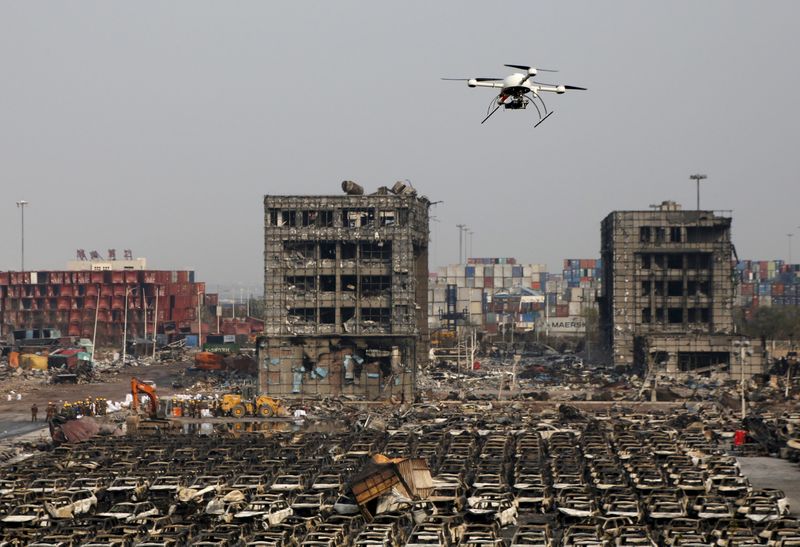By Fang Yan and Matthew Miller
BEIJING (Reuters) - When an explosion devastated parts of China's Tianjin port in August, one insurance company turned to Chinese-made drones to help analyse the rubble and estimate the damages.
Comparing satellite photographs of the site ahead of the blast with high-resolution images taken later by drones, the People's Insurance Company of China (PICC) was able to determine how many vehicles had been destroyed and total the losses for German automaker Volkswagen (DE:VOWG_p).
"There was nothing left but a big hole in the ground," Lin Changqing, a deputy general manager at PICC Property and Casualty Co told Reuters. With the government maintaining a one kilometre exclusion zone around the site, an accurate loss assessment would have been "mission impossible" without unpiloted aircraft, he added.
Chinese drone developers are racking up an impressive list of aerial solutions for a growing variety of demands, from police surveillance to agricultural mapping and traffic management. Already well established as a world leader in drone manufacturing, China is slowly emerging as a world-class innovator, not just a duplicator of foreign designs.
"People have been calling China 'copy cats' for a long time. That's still true in a lot of industries, but when it comes to drones China is no copycat," said Joe Tymczyszyn, a senior adviser and former executive director for the U.S.-China Aviation Cooperation Program.
Chinese firm SZ DJI Technology Co, the world's biggest consumer drone maker, will open its first flagship retail store in Shenzhen on Sunday. The company claims 70 percent of the commercial market worldwide and a larger portion of the consumer market.
Others are lining up to replicate SZ's success. Wuhan Airbird UAV Co Ltd designs and maintains drones for government, corporate and private users. But its traffic monitoring micro-drone - so small it can be launched from a car window - is proving a hit with the car-driving public.
The privately-held manufacturer expects revenue to rise 50 percent this year to 18 million yuan (2 million pounds), and employs about 45 engineers and mechanics.
GROUND RULES
Research firm Taibo Intelligence forecasts Chinese drone industry revenue to more than double to 2.5 billion yuan ($388 million) this year and grow by as much as eight fold to 20 billion yuan by 2020.
With revenues booming and participants rushing to stake out territory, regulators are trying to rein in the exuberance and set some ground-rules for the industry.
China's aviation regulator this month published provisional rules aiming to hold drone operators more accountable and control where commercial and private unmanned aerial vehicles may fly.
The rules, which are less severe than regulations being considered by the U.S. and Europe, came after a series of security breaches, including an incident where a civilian drone photographed a Chinese fighter jet as it prepared to land.
While some chafe at the government scrutiny, other industry players welcome the attention.
"It's like saying traffic rules have hurt the development of the car industry," said Ke Yubao, executive secretary-general of the government-backed China Aircraft Owners and Pilots Association.
Wuhan Airbird Chief Executive Wang Xiaobo said tighter regulation was needed to improve industry safety. "Once a major accident happens it will be too late," he said.
The military continues to control about 70 percent of China's airspace, and demands that all drone flights receive approval before entering controlled areas. Even so, the vast majority of drone operators in China are untrained and fly without licences.
"Unlicensed flights need to be addressed sooner or later," said Yan Jianqiao, marketing chief at Shenzhen AEE Technology Co. Ltd, which supplies high-performance drones for police in Europe and the U.S. military.
"It will become a liability for manufacturers otherwise."
BRIGHT SPARKS
Many of China's drone pioneers can be found at Beihang University, the country's top aviation school, where students are encouraged to commercialise their research.
The school has attracted the attention of Innovation Works, the venture capital firm founded by Google's former China chief Kai-Fu Lee, which invested 4 million yuan in Hao Heng Zeng Tu, a student start-up helmed by Chu Zhen, a 25-year-old satellite navigation major.
Other investors include Intel Corp (O:INTC), which in August invested more than $60 million in Yuneec International, one of China's biggest electric drone makers.
"Twenty years ago we used bicycles to measure the size of big farm fields," PICC chief of disaster research Guo Qing said.
"A drone can now do the job in five minutes."

($1 = 6.4588 Chinese yuan renminbi)